Financial Management: Evaluating & Improving Financial Performance
VerifiedAdded on 2023/06/11
|15
|2725
|295
Report
AI Summary
This report provides a comprehensive overview of financial management, emphasizing its importance in organizational success through effective fund procurement and resource utilization. It delves into the main financial statements—balance sheets, income statements, and cash flow statements—explaining their utility in assessing a company's financial health. The report also illustrates the application of financial ratios for trend analysis, competitive comparison, and operational efficiency evaluation. Practical examples are provided using templates to demonstrate the calculation and interpretation of key ratios such as gross profit ratio, net profit ratio, current ratio, and stock turnover ratio. Furthermore, the report outlines a process for improving a company's financial performance, focusing on cost reduction and strategic resource management. This document is available on Desklib, a platform offering a wide array of study tools and solved assignments for students.

Importance of Financial
Management
Management
Paraphrase This Document
Need a fresh take? Get an instant paraphrase of this document with our AI Paraphraser
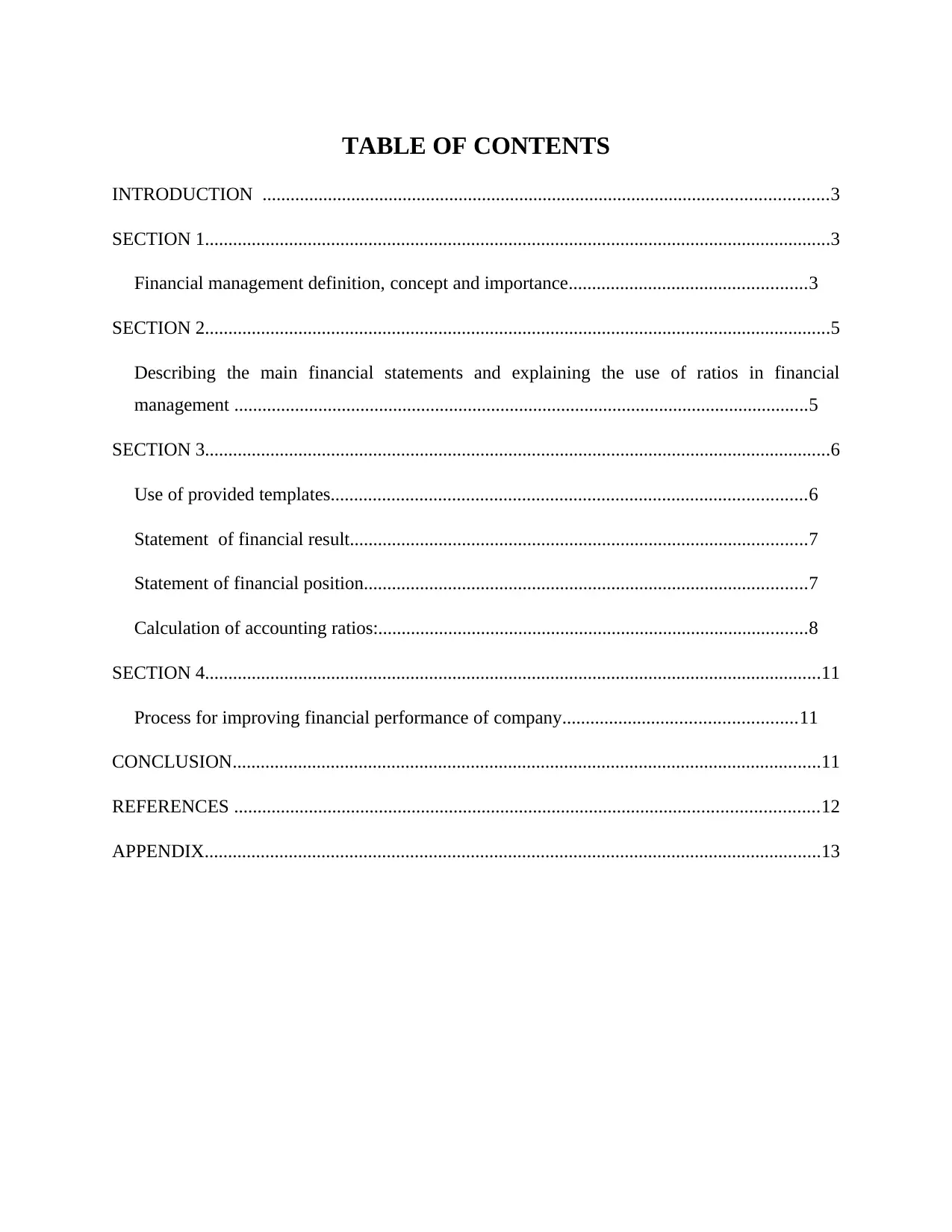
TABLE OF CONTENTS
INTRODUCTION .........................................................................................................................3
SECTION 1......................................................................................................................................3
Financial management definition, concept and importance...................................................3
SECTION 2......................................................................................................................................5
Describing the main financial statements and explaining the use of ratios in financial
management ...........................................................................................................................5
SECTION 3......................................................................................................................................6
Use of provided templates......................................................................................................6
Statement of financial result..................................................................................................7
Statement of financial position...............................................................................................7
Calculation of accounting ratios:............................................................................................8
SECTION 4....................................................................................................................................11
Process for improving financial performance of company..................................................11
CONCLUSION..............................................................................................................................11
REFERENCES .............................................................................................................................12
APPENDIX....................................................................................................................................13
INTRODUCTION .........................................................................................................................3
SECTION 1......................................................................................................................................3
Financial management definition, concept and importance...................................................3
SECTION 2......................................................................................................................................5
Describing the main financial statements and explaining the use of ratios in financial
management ...........................................................................................................................5
SECTION 3......................................................................................................................................6
Use of provided templates......................................................................................................6
Statement of financial result..................................................................................................7
Statement of financial position...............................................................................................7
Calculation of accounting ratios:............................................................................................8
SECTION 4....................................................................................................................................11
Process for improving financial performance of company..................................................11
CONCLUSION..............................................................................................................................11
REFERENCES .............................................................................................................................12
APPENDIX....................................................................................................................................13
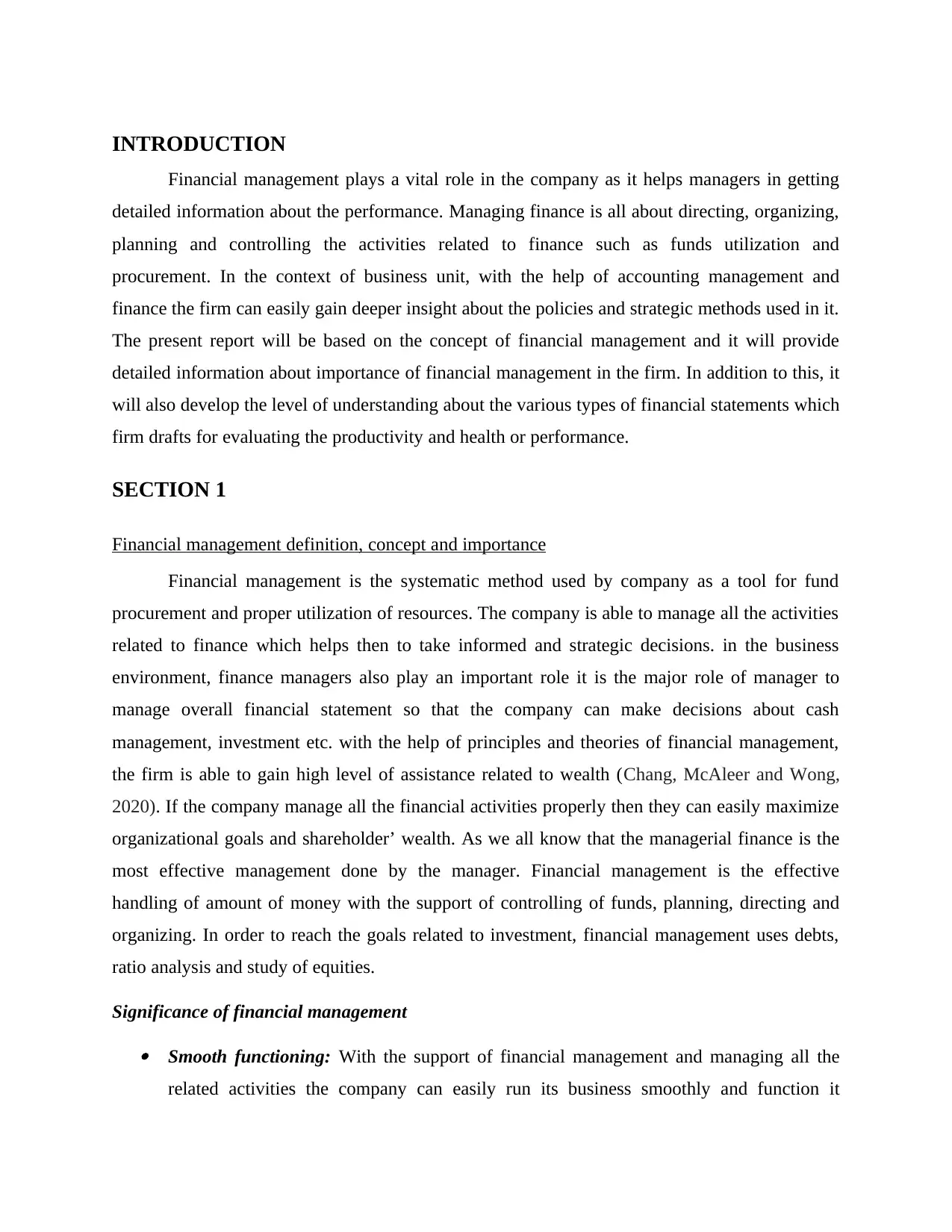
INTRODUCTION
Financial management plays a vital role in the company as it helps managers in getting
detailed information about the performance. Managing finance is all about directing, organizing,
planning and controlling the activities related to finance such as funds utilization and
procurement. In the context of business unit, with the help of accounting management and
finance the firm can easily gain deeper insight about the policies and strategic methods used in it.
The present report will be based on the concept of financial management and it will provide
detailed information about importance of financial management in the firm. In addition to this, it
will also develop the level of understanding about the various types of financial statements which
firm drafts for evaluating the productivity and health or performance.
SECTION 1
Financial management definition, concept and importance
Financial management is the systematic method used by company as a tool for fund
procurement and proper utilization of resources. The company is able to manage all the activities
related to finance which helps then to take informed and strategic decisions. in the business
environment, finance managers also play an important role it is the major role of manager to
manage overall financial statement so that the company can make decisions about cash
management, investment etc. with the help of principles and theories of financial management,
the firm is able to gain high level of assistance related to wealth (Chang, McAleer and Wong,
2020). If the company manage all the financial activities properly then they can easily maximize
organizational goals and shareholder’ wealth. As we all know that the managerial finance is the
most effective management done by the manager. Financial management is the effective
handling of amount of money with the support of controlling of funds, planning, directing and
organizing. In order to reach the goals related to investment, financial management uses debts,
ratio analysis and study of equities.
Significance of financial management Smooth functioning: With the support of financial management and managing all the
related activities the company can easily run its business smoothly and function it
Financial management plays a vital role in the company as it helps managers in getting
detailed information about the performance. Managing finance is all about directing, organizing,
planning and controlling the activities related to finance such as funds utilization and
procurement. In the context of business unit, with the help of accounting management and
finance the firm can easily gain deeper insight about the policies and strategic methods used in it.
The present report will be based on the concept of financial management and it will provide
detailed information about importance of financial management in the firm. In addition to this, it
will also develop the level of understanding about the various types of financial statements which
firm drafts for evaluating the productivity and health or performance.
SECTION 1
Financial management definition, concept and importance
Financial management is the systematic method used by company as a tool for fund
procurement and proper utilization of resources. The company is able to manage all the activities
related to finance which helps then to take informed and strategic decisions. in the business
environment, finance managers also play an important role it is the major role of manager to
manage overall financial statement so that the company can make decisions about cash
management, investment etc. with the help of principles and theories of financial management,
the firm is able to gain high level of assistance related to wealth (Chang, McAleer and Wong,
2020). If the company manage all the financial activities properly then they can easily maximize
organizational goals and shareholder’ wealth. As we all know that the managerial finance is the
most effective management done by the manager. Financial management is the effective
handling of amount of money with the support of controlling of funds, planning, directing and
organizing. In order to reach the goals related to investment, financial management uses debts,
ratio analysis and study of equities.
Significance of financial management Smooth functioning: With the support of financial management and managing all the
related activities the company can easily run its business smoothly and function it
⊘ This is a preview!⊘
Do you want full access?
Subscribe today to unlock all pages.

Trusted by 1+ million students worldwide
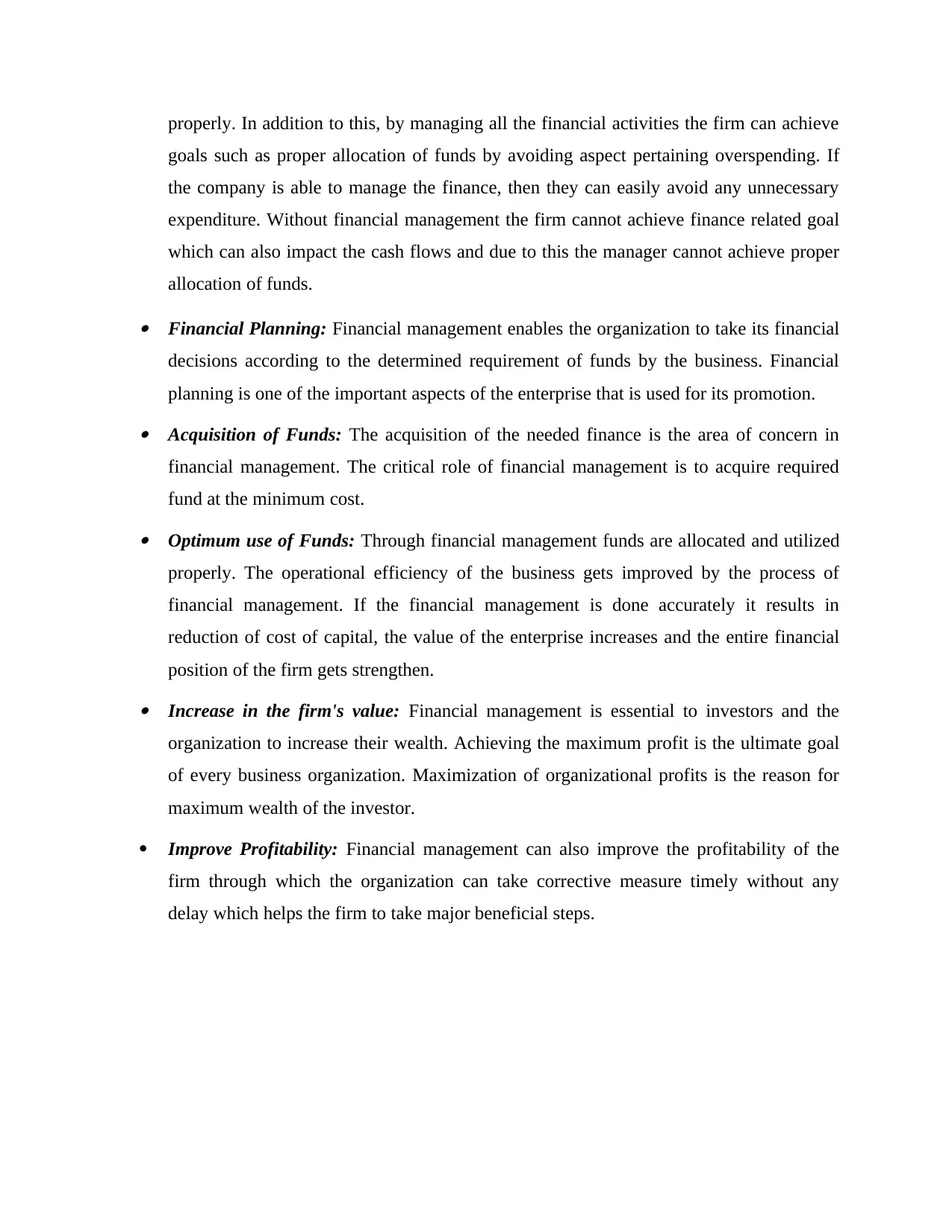
properly. In addition to this, by managing all the financial activities the firm can achieve
goals such as proper allocation of funds by avoiding aspect pertaining overspending. If
the company is able to manage the finance, then they can easily avoid any unnecessary
expenditure. Without financial management the firm cannot achieve finance related goal
which can also impact the cash flows and due to this the manager cannot achieve proper
allocation of funds. Financial Planning: Financial management enables the organization to take its financial
decisions according to the determined requirement of funds by the business. Financial
planning is one of the important aspects of the enterprise that is used for its promotion. Acquisition of Funds: The acquisition of the needed finance is the area of concern in
financial management. The critical role of financial management is to acquire required
fund at the minimum cost. Optimum use of Funds: Through financial management funds are allocated and utilized
properly. The operational efficiency of the business gets improved by the process of
financial management. If the financial management is done accurately it results in
reduction of cost of capital, the value of the enterprise increases and the entire financial
position of the firm gets strengthen. Increase in the firm's value: Financial management is essential to investors and the
organization to increase their wealth. Achieving the maximum profit is the ultimate goal
of every business organization. Maximization of organizational profits is the reason for
maximum wealth of the investor.
Improve Profitability: Financial management can also improve the profitability of the
firm through which the organization can take corrective measure timely without any
delay which helps the firm to take major beneficial steps.
goals such as proper allocation of funds by avoiding aspect pertaining overspending. If
the company is able to manage the finance, then they can easily avoid any unnecessary
expenditure. Without financial management the firm cannot achieve finance related goal
which can also impact the cash flows and due to this the manager cannot achieve proper
allocation of funds. Financial Planning: Financial management enables the organization to take its financial
decisions according to the determined requirement of funds by the business. Financial
planning is one of the important aspects of the enterprise that is used for its promotion. Acquisition of Funds: The acquisition of the needed finance is the area of concern in
financial management. The critical role of financial management is to acquire required
fund at the minimum cost. Optimum use of Funds: Through financial management funds are allocated and utilized
properly. The operational efficiency of the business gets improved by the process of
financial management. If the financial management is done accurately it results in
reduction of cost of capital, the value of the enterprise increases and the entire financial
position of the firm gets strengthen. Increase in the firm's value: Financial management is essential to investors and the
organization to increase their wealth. Achieving the maximum profit is the ultimate goal
of every business organization. Maximization of organizational profits is the reason for
maximum wealth of the investor.
Improve Profitability: Financial management can also improve the profitability of the
firm through which the organization can take corrective measure timely without any
delay which helps the firm to take major beneficial steps.
Paraphrase This Document
Need a fresh take? Get an instant paraphrase of this document with our AI Paraphraser
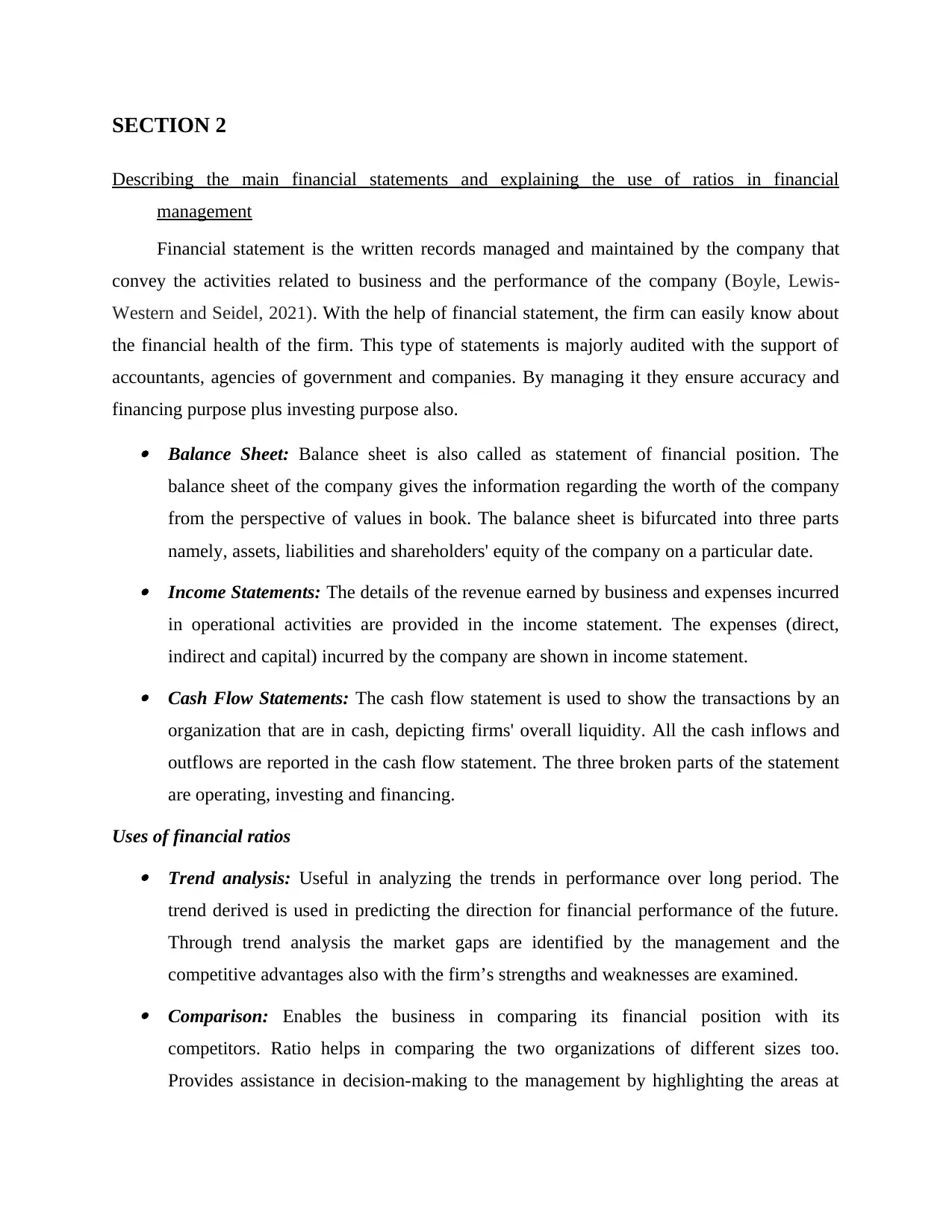
SECTION 2
Describing the main financial statements and explaining the use of ratios in financial
management
Financial statement is the written records managed and maintained by the company that
convey the activities related to business and the performance of the company (Boyle, Lewis-
Western and Seidel, 2021). With the help of financial statement, the firm can easily know about
the financial health of the firm. This type of statements is majorly audited with the support of
accountants, agencies of government and companies. By managing it they ensure accuracy and
financing purpose plus investing purpose also. Balance Sheet: Balance sheet is also called as statement of financial position. The
balance sheet of the company gives the information regarding the worth of the company
from the perspective of values in book. The balance sheet is bifurcated into three parts
namely, assets, liabilities and shareholders' equity of the company on a particular date. Income Statements: The details of the revenue earned by business and expenses incurred
in operational activities are provided in the income statement. The expenses (direct,
indirect and capital) incurred by the company are shown in income statement. Cash Flow Statements: The cash flow statement is used to show the transactions by an
organization that are in cash, depicting firms' overall liquidity. All the cash inflows and
outflows are reported in the cash flow statement. The three broken parts of the statement
are operating, investing and financing.
Uses of financial ratios Trend analysis: Useful in analyzing the trends in performance over long period. The
trend derived is used in predicting the direction for financial performance of the future.
Through trend analysis the market gaps are identified by the management and the
competitive advantages also with the firm’s strengths and weaknesses are examined. Comparison: Enables the business in comparing its financial position with its
competitors. Ratio helps in comparing the two organizations of different sizes too.
Provides assistance in decision-making to the management by highlighting the areas at
Describing the main financial statements and explaining the use of ratios in financial
management
Financial statement is the written records managed and maintained by the company that
convey the activities related to business and the performance of the company (Boyle, Lewis-
Western and Seidel, 2021). With the help of financial statement, the firm can easily know about
the financial health of the firm. This type of statements is majorly audited with the support of
accountants, agencies of government and companies. By managing it they ensure accuracy and
financing purpose plus investing purpose also. Balance Sheet: Balance sheet is also called as statement of financial position. The
balance sheet of the company gives the information regarding the worth of the company
from the perspective of values in book. The balance sheet is bifurcated into three parts
namely, assets, liabilities and shareholders' equity of the company on a particular date. Income Statements: The details of the revenue earned by business and expenses incurred
in operational activities are provided in the income statement. The expenses (direct,
indirect and capital) incurred by the company are shown in income statement. Cash Flow Statements: The cash flow statement is used to show the transactions by an
organization that are in cash, depicting firms' overall liquidity. All the cash inflows and
outflows are reported in the cash flow statement. The three broken parts of the statement
are operating, investing and financing.
Uses of financial ratios Trend analysis: Useful in analyzing the trends in performance over long period. The
trend derived is used in predicting the direction for financial performance of the future.
Through trend analysis the market gaps are identified by the management and the
competitive advantages also with the firm’s strengths and weaknesses are examined. Comparison: Enables the business in comparing its financial position with its
competitors. Ratio helps in comparing the two organizations of different sizes too.
Provides assistance in decision-making to the management by highlighting the areas at
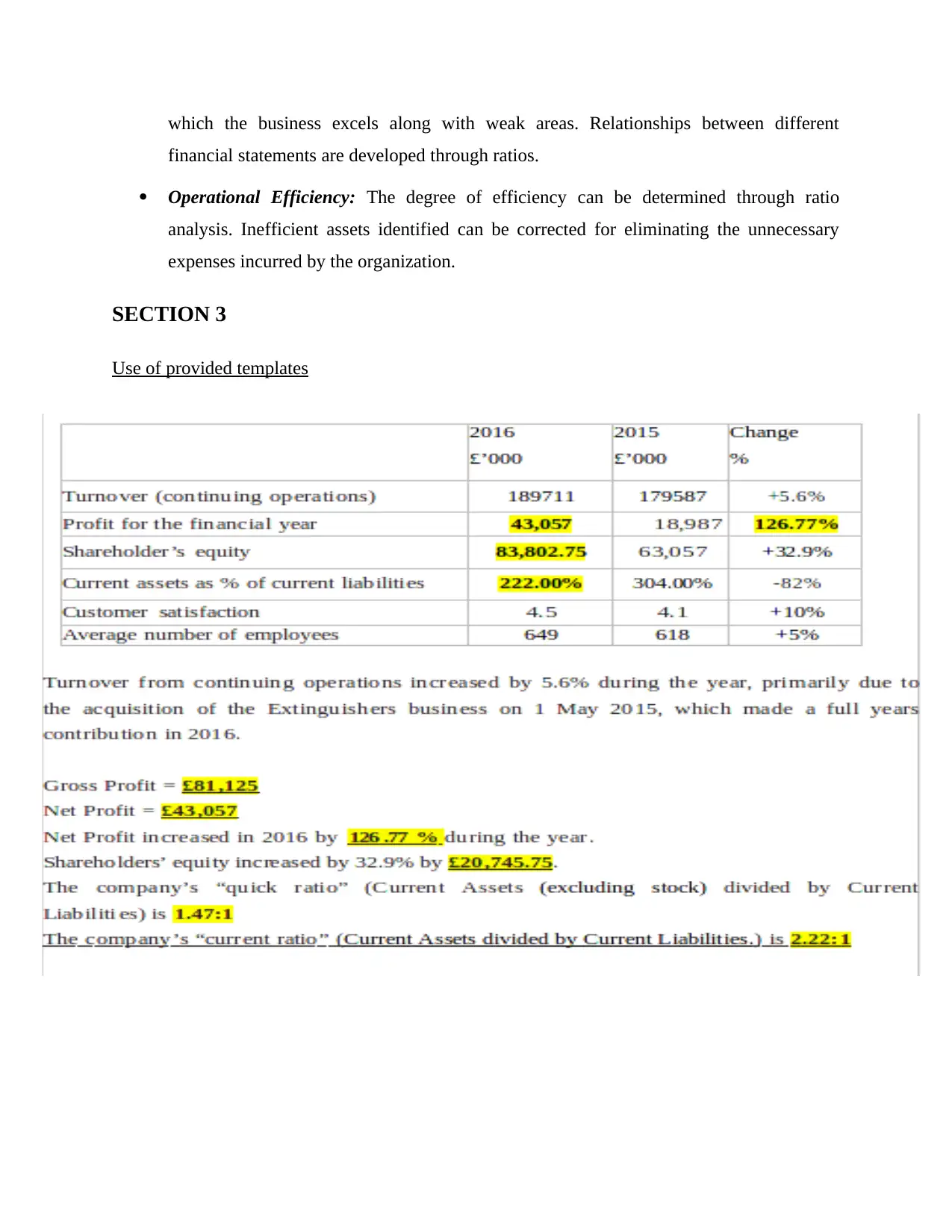
which the business excels along with weak areas. Relationships between different
financial statements are developed through ratios.
Operational Efficiency: The degree of efficiency can be determined through ratio
analysis. Inefficient assets identified can be corrected for eliminating the unnecessary
expenses incurred by the organization.
SECTION 3
Use of provided templates
financial statements are developed through ratios.
Operational Efficiency: The degree of efficiency can be determined through ratio
analysis. Inefficient assets identified can be corrected for eliminating the unnecessary
expenses incurred by the organization.
SECTION 3
Use of provided templates
⊘ This is a preview!⊘
Do you want full access?
Subscribe today to unlock all pages.

Trusted by 1+ million students worldwide
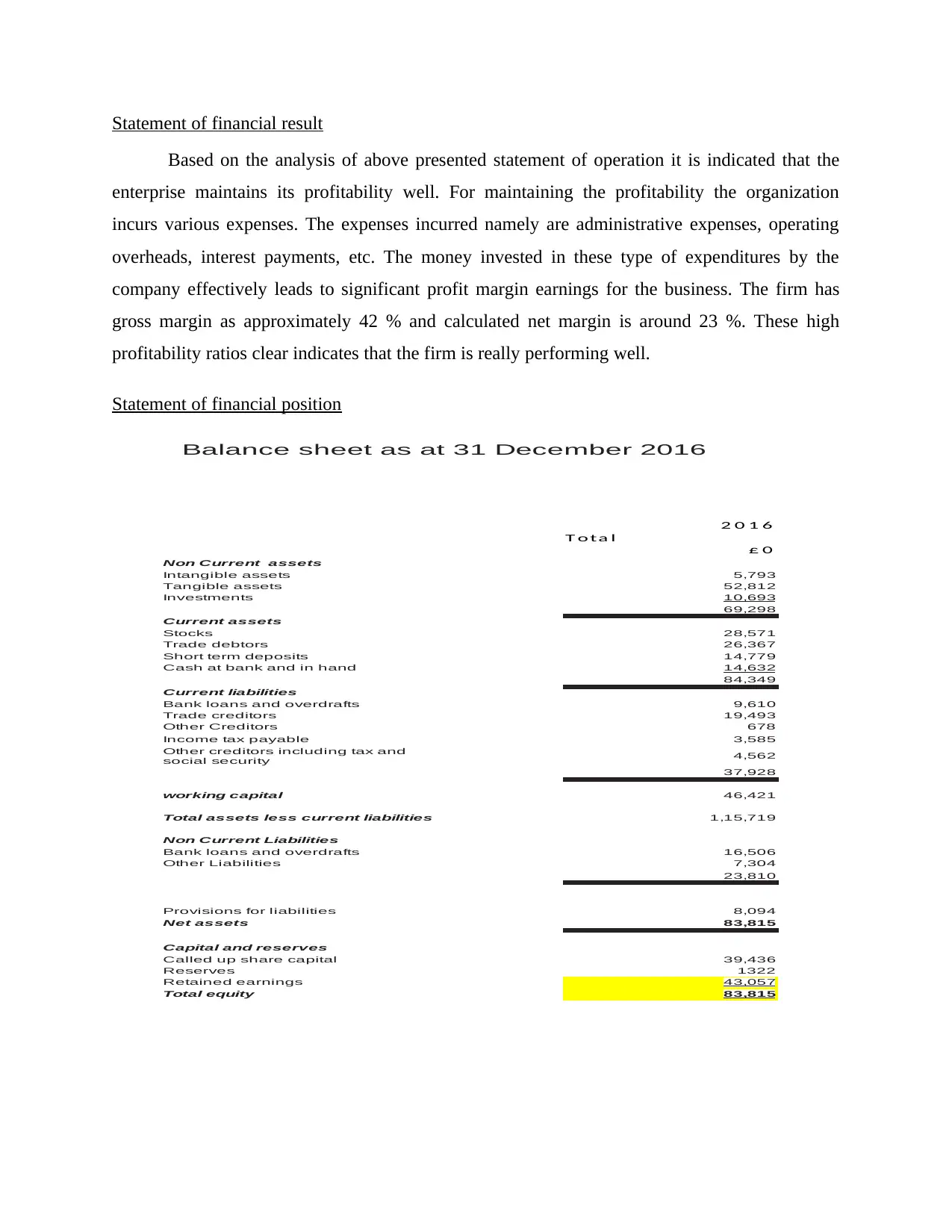
Statement of financial result
Based on the analysis of above presented statement of operation it is indicated that the
enterprise maintains its profitability well. For maintaining the profitability the organization
incurs various expenses. The expenses incurred namely are administrative expenses, operating
overheads, interest payments, etc. The money invested in these type of expenditures by the
company effectively leads to significant profit margin earnings for the business. The firm has
gross margin as approximately 42 % and calculated net margin is around 23 %. These high
profitability ratios clear indicates that the firm is really performing well.
Statement of financial position
Balance sheet as at 31 December 2016
2 0 1 6
T ota l
£ 0
Non Current assets
Intangible assets 5,793
Tangible assets 52,812
Investments 10,693
69,298
Current assets
Stocks 28,571
Trade debtors 26,367
Short term deposits 14,779
Cash at bank and in hand 14,632
84,349
Current liabilities
Bank loans and overdrafts 9,610
Trade creditors 19,493
Other Creditors 678
Income tax payable 3,585
4,562
37,928
working capital 46,421
Total assets less current liabilities 1,15,719
Non Current Liabilities
Bank loans and overdrafts 16,506
Other Liabilities 7,304
23,810
Provisions for liabilities 8,094
Net assets 83,815
Capital and reserves
Called up share capital 39,436
Reserves 1322
Retained earnings 43,057
Total equity 83,815
Other creditors including tax and
social security
Based on the analysis of above presented statement of operation it is indicated that the
enterprise maintains its profitability well. For maintaining the profitability the organization
incurs various expenses. The expenses incurred namely are administrative expenses, operating
overheads, interest payments, etc. The money invested in these type of expenditures by the
company effectively leads to significant profit margin earnings for the business. The firm has
gross margin as approximately 42 % and calculated net margin is around 23 %. These high
profitability ratios clear indicates that the firm is really performing well.
Statement of financial position
Balance sheet as at 31 December 2016
2 0 1 6
T ota l
£ 0
Non Current assets
Intangible assets 5,793
Tangible assets 52,812
Investments 10,693
69,298
Current assets
Stocks 28,571
Trade debtors 26,367
Short term deposits 14,779
Cash at bank and in hand 14,632
84,349
Current liabilities
Bank loans and overdrafts 9,610
Trade creditors 19,493
Other Creditors 678
Income tax payable 3,585
4,562
37,928
working capital 46,421
Total assets less current liabilities 1,15,719
Non Current Liabilities
Bank loans and overdrafts 16,506
Other Liabilities 7,304
23,810
Provisions for liabilities 8,094
Net assets 83,815
Capital and reserves
Called up share capital 39,436
Reserves 1322
Retained earnings 43,057
Total equity 83,815
Other creditors including tax and
social security
Paraphrase This Document
Need a fresh take? Get an instant paraphrase of this document with our AI Paraphraser
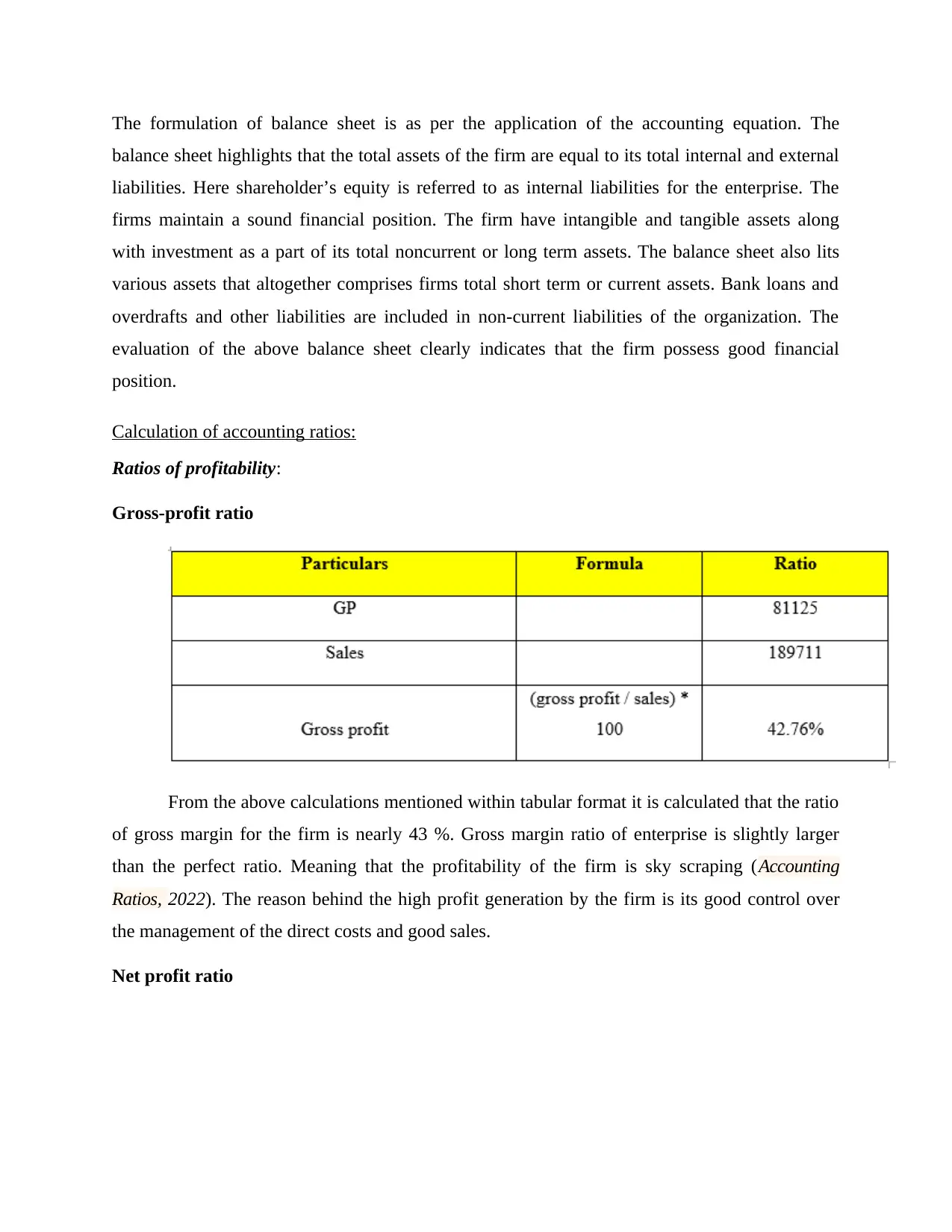
The formulation of balance sheet is as per the application of the accounting equation. The
balance sheet highlights that the total assets of the firm are equal to its total internal and external
liabilities. Here shareholder’s equity is referred to as internal liabilities for the enterprise. The
firms maintain a sound financial position. The firm have intangible and tangible assets along
with investment as a part of its total noncurrent or long term assets. The balance sheet also lits
various assets that altogether comprises firms total short term or current assets. Bank loans and
overdrafts and other liabilities are included in non-current liabilities of the organization. The
evaluation of the above balance sheet clearly indicates that the firm possess good financial
position.
Calculation of accounting ratios:
Ratios of profitability:
Gross-profit ratio
From the above calculations mentioned within tabular format it is calculated that the ratio
of gross margin for the firm is nearly 43 %. Gross margin ratio of enterprise is slightly larger
than the perfect ratio. Meaning that the profitability of the firm is sky scraping (Accounting
Ratios, 2022). The reason behind the high profit generation by the firm is its good control over
the management of the direct costs and good sales.
Net profit ratio
balance sheet highlights that the total assets of the firm are equal to its total internal and external
liabilities. Here shareholder’s equity is referred to as internal liabilities for the enterprise. The
firms maintain a sound financial position. The firm have intangible and tangible assets along
with investment as a part of its total noncurrent or long term assets. The balance sheet also lits
various assets that altogether comprises firms total short term or current assets. Bank loans and
overdrafts and other liabilities are included in non-current liabilities of the organization. The
evaluation of the above balance sheet clearly indicates that the firm possess good financial
position.
Calculation of accounting ratios:
Ratios of profitability:
Gross-profit ratio
From the above calculations mentioned within tabular format it is calculated that the ratio
of gross margin for the firm is nearly 43 %. Gross margin ratio of enterprise is slightly larger
than the perfect ratio. Meaning that the profitability of the firm is sky scraping (Accounting
Ratios, 2022). The reason behind the high profit generation by the firm is its good control over
the management of the direct costs and good sales.
Net profit ratio
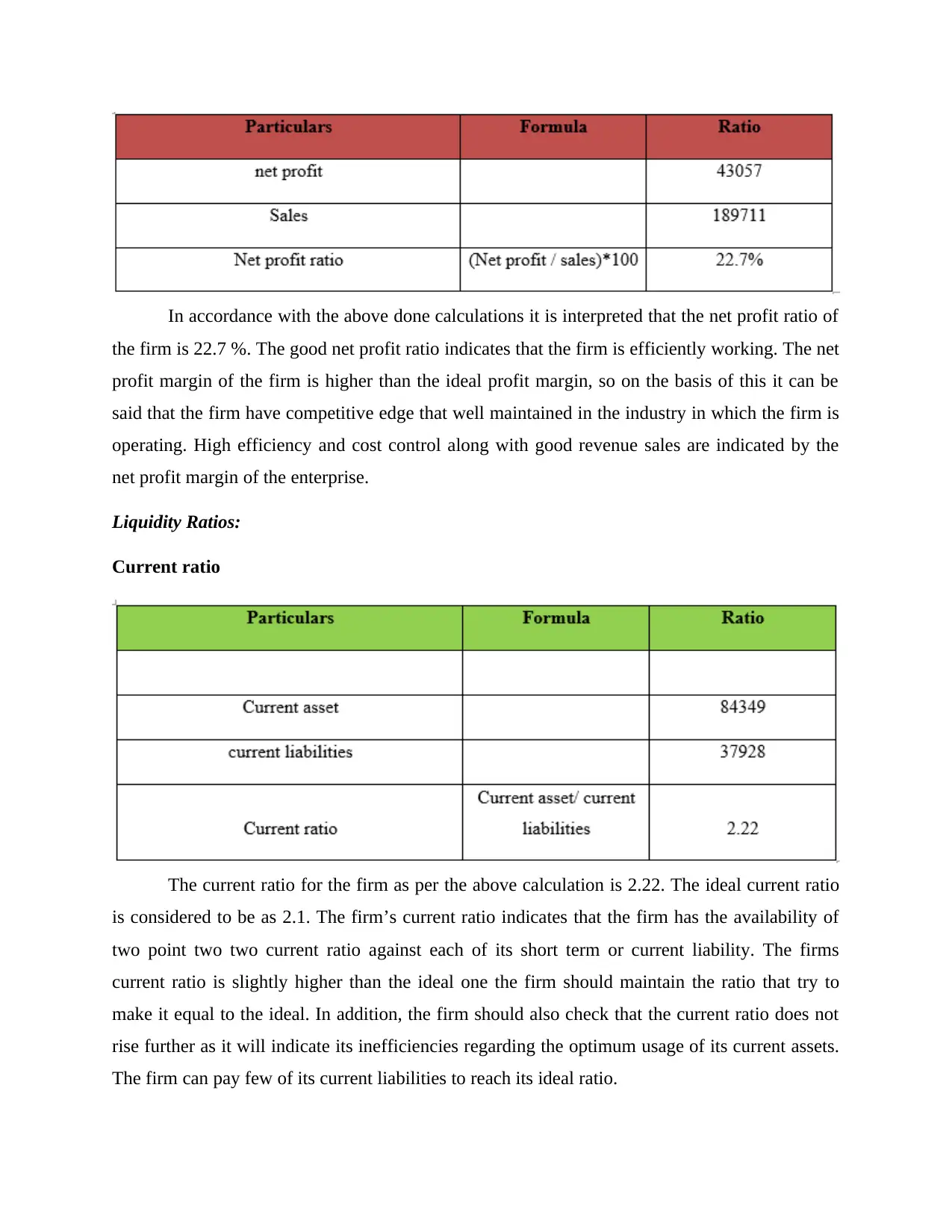
In accordance with the above done calculations it is interpreted that the net profit ratio of
the firm is 22.7 %. The good net profit ratio indicates that the firm is efficiently working. The net
profit margin of the firm is higher than the ideal profit margin, so on the basis of this it can be
said that the firm have competitive edge that well maintained in the industry in which the firm is
operating. High efficiency and cost control along with good revenue sales are indicated by the
net profit margin of the enterprise.
Liquidity Ratios:
Current ratio
The current ratio for the firm as per the above calculation is 2.22. The ideal current ratio
is considered to be as 2.1. The firm’s current ratio indicates that the firm has the availability of
two point two two current ratio against each of its short term or current liability. The firms
current ratio is slightly higher than the ideal one the firm should maintain the ratio that try to
make it equal to the ideal. In addition, the firm should also check that the current ratio does not
rise further as it will indicate its inefficiencies regarding the optimum usage of its current assets.
The firm can pay few of its current liabilities to reach its ideal ratio.
the firm is 22.7 %. The good net profit ratio indicates that the firm is efficiently working. The net
profit margin of the firm is higher than the ideal profit margin, so on the basis of this it can be
said that the firm have competitive edge that well maintained in the industry in which the firm is
operating. High efficiency and cost control along with good revenue sales are indicated by the
net profit margin of the enterprise.
Liquidity Ratios:
Current ratio
The current ratio for the firm as per the above calculation is 2.22. The ideal current ratio
is considered to be as 2.1. The firm’s current ratio indicates that the firm has the availability of
two point two two current ratio against each of its short term or current liability. The firms
current ratio is slightly higher than the ideal one the firm should maintain the ratio that try to
make it equal to the ideal. In addition, the firm should also check that the current ratio does not
rise further as it will indicate its inefficiencies regarding the optimum usage of its current assets.
The firm can pay few of its current liabilities to reach its ideal ratio.
⊘ This is a preview!⊘
Do you want full access?
Subscribe today to unlock all pages.

Trusted by 1+ million students worldwide
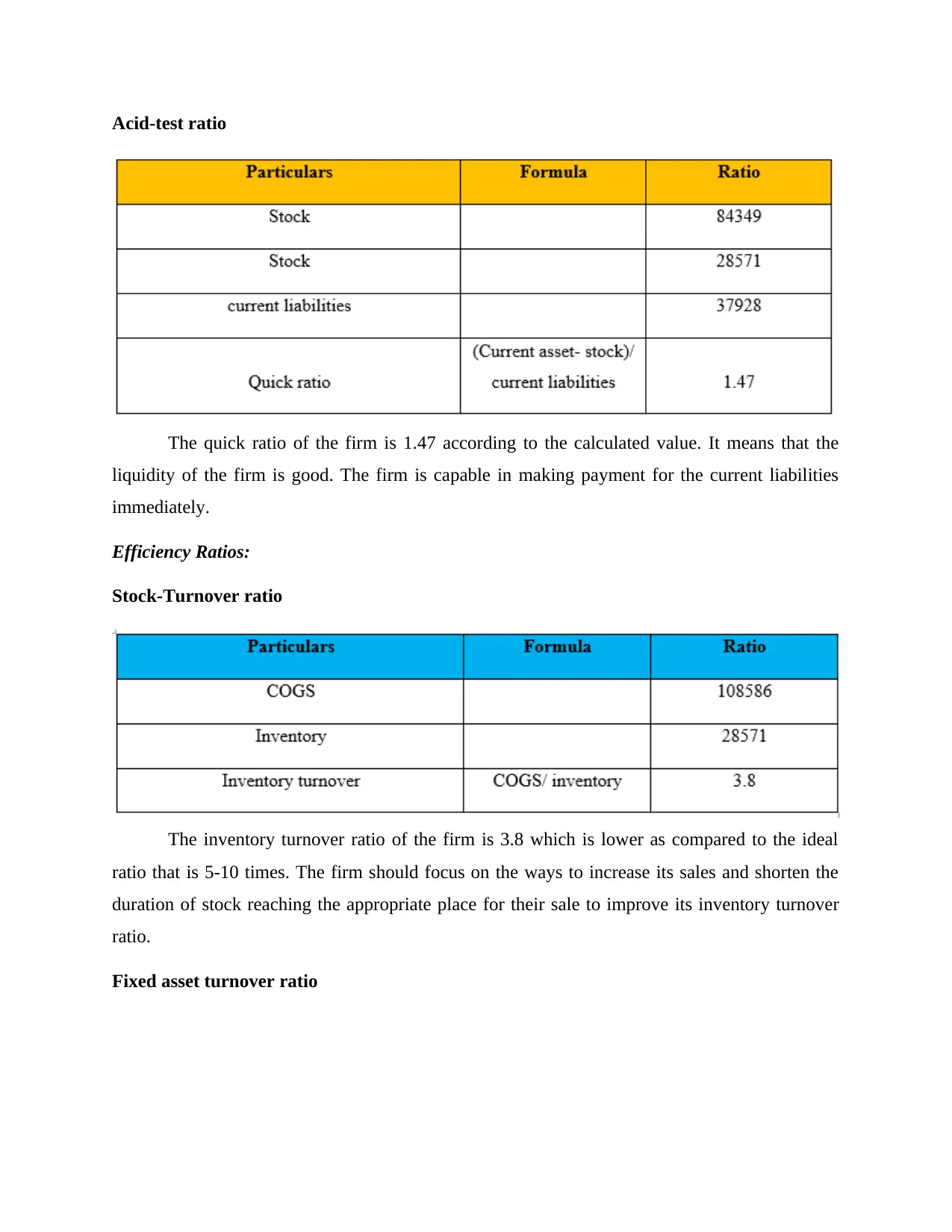
Acid-test ratio
The quick ratio of the firm is 1.47 according to the calculated value. It means that the
liquidity of the firm is good. The firm is capable in making payment for the current liabilities
immediately.
Efficiency Ratios:
Stock-Turnover ratio
The inventory turnover ratio of the firm is 3.8 which is lower as compared to the ideal
ratio that is 5-10 times. The firm should focus on the ways to increase its sales and shorten the
duration of stock reaching the appropriate place for their sale to improve its inventory turnover
ratio.
Fixed asset turnover ratio
The quick ratio of the firm is 1.47 according to the calculated value. It means that the
liquidity of the firm is good. The firm is capable in making payment for the current liabilities
immediately.
Efficiency Ratios:
Stock-Turnover ratio
The inventory turnover ratio of the firm is 3.8 which is lower as compared to the ideal
ratio that is 5-10 times. The firm should focus on the ways to increase its sales and shorten the
duration of stock reaching the appropriate place for their sale to improve its inventory turnover
ratio.
Fixed asset turnover ratio
Paraphrase This Document
Need a fresh take? Get an instant paraphrase of this document with our AI Paraphraser
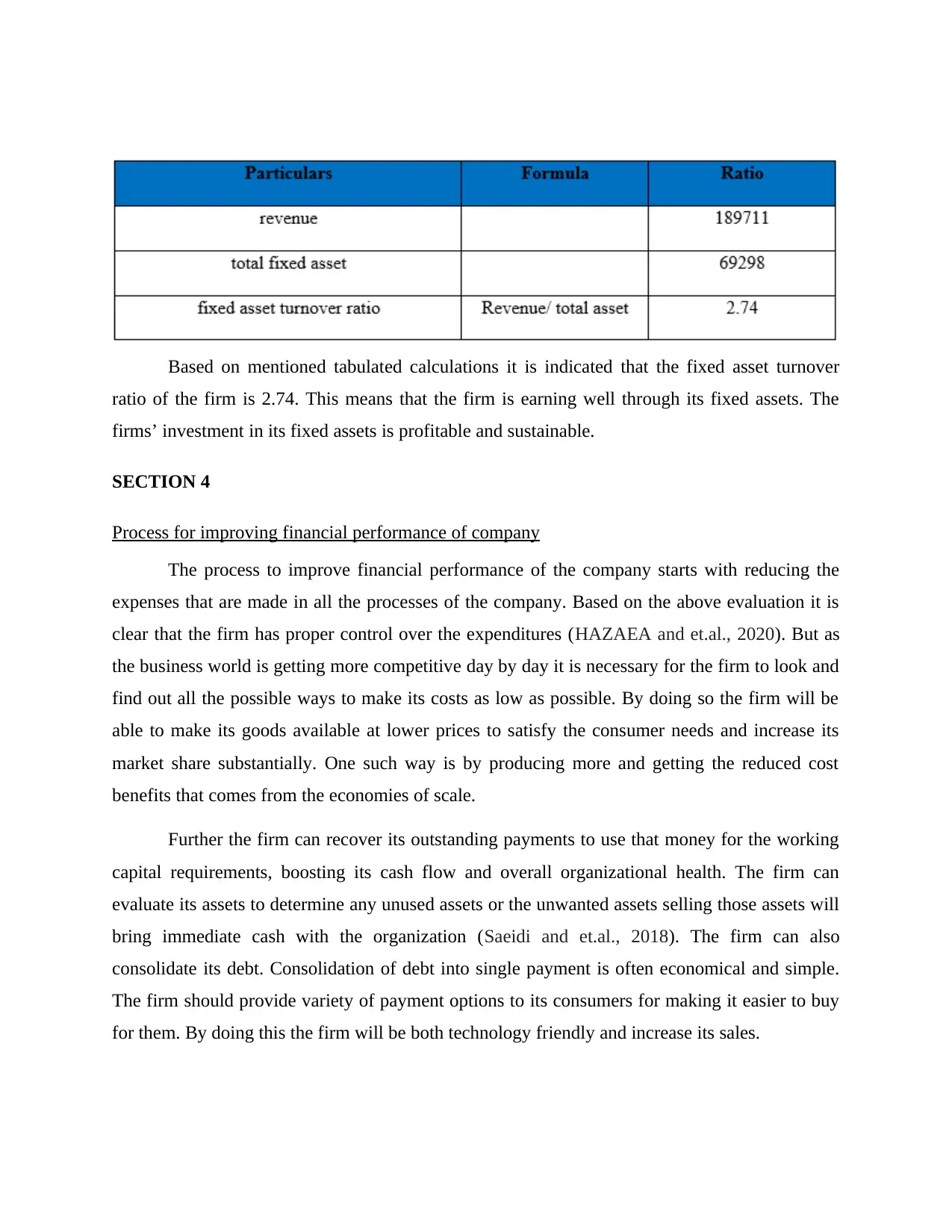
Based on mentioned tabulated calculations it is indicated that the fixed asset turnover
ratio of the firm is 2.74. This means that the firm is earning well through its fixed assets. The
firms’ investment in its fixed assets is profitable and sustainable.
SECTION 4
Process for improving financial performance of company
The process to improve financial performance of the company starts with reducing the
expenses that are made in all the processes of the company. Based on the above evaluation it is
clear that the firm has proper control over the expenditures (HAZAEA and et.al., 2020). But as
the business world is getting more competitive day by day it is necessary for the firm to look and
find out all the possible ways to make its costs as low as possible. By doing so the firm will be
able to make its goods available at lower prices to satisfy the consumer needs and increase its
market share substantially. One such way is by producing more and getting the reduced cost
benefits that comes from the economies of scale.
Further the firm can recover its outstanding payments to use that money for the working
capital requirements, boosting its cash flow and overall organizational health. The firm can
evaluate its assets to determine any unused assets or the unwanted assets selling those assets will
bring immediate cash with the organization (Saeidi and et.al., 2018). The firm can also
consolidate its debt. Consolidation of debt into single payment is often economical and simple.
The firm should provide variety of payment options to its consumers for making it easier to buy
for them. By doing this the firm will be both technology friendly and increase its sales.
ratio of the firm is 2.74. This means that the firm is earning well through its fixed assets. The
firms’ investment in its fixed assets is profitable and sustainable.
SECTION 4
Process for improving financial performance of company
The process to improve financial performance of the company starts with reducing the
expenses that are made in all the processes of the company. Based on the above evaluation it is
clear that the firm has proper control over the expenditures (HAZAEA and et.al., 2020). But as
the business world is getting more competitive day by day it is necessary for the firm to look and
find out all the possible ways to make its costs as low as possible. By doing so the firm will be
able to make its goods available at lower prices to satisfy the consumer needs and increase its
market share substantially. One such way is by producing more and getting the reduced cost
benefits that comes from the economies of scale.
Further the firm can recover its outstanding payments to use that money for the working
capital requirements, boosting its cash flow and overall organizational health. The firm can
evaluate its assets to determine any unused assets or the unwanted assets selling those assets will
bring immediate cash with the organization (Saeidi and et.al., 2018). The firm can also
consolidate its debt. Consolidation of debt into single payment is often economical and simple.
The firm should provide variety of payment options to its consumers for making it easier to buy
for them. By doing this the firm will be both technology friendly and increase its sales.

CONCLUSION
To conclude, financial management is an important for the company as it facilitates
optimum utilization of the resources. By evaluating the report, it has been concluded that the
company is able to know the financial health and performance by managing financial
management and statement related to it such as balance sheet, cash flow and income statement.
To conclude, financial management is an important for the company as it facilitates
optimum utilization of the resources. By evaluating the report, it has been concluded that the
company is able to know the financial health and performance by managing financial
management and statement related to it such as balance sheet, cash flow and income statement.
⊘ This is a preview!⊘
Do you want full access?
Subscribe today to unlock all pages.

Trusted by 1+ million students worldwide
1 out of 15
Related Documents
Your All-in-One AI-Powered Toolkit for Academic Success.
+13062052269
info@desklib.com
Available 24*7 on WhatsApp / Email
![[object Object]](/_next/static/media/star-bottom.7253800d.svg)
Unlock your academic potential
Copyright © 2020–2025 A2Z Services. All Rights Reserved. Developed and managed by ZUCOL.



